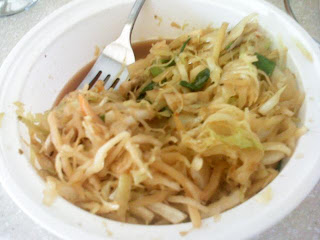Mu Shu Vegetables and American vs. Chinese Chinese Food
Breakfast: Brussels sprouts, 3 sweet potato fries
Lunch: Oatmeal
Dinner: Mu Shu Vegetables (about half, no pancakes)

I love Mu Shu Vegetables. Before I went vegan, I loved Mu Shu Pork - I ate it on my birthday and whenever it was available at Chinese restaurants, and I wondered how I would ever replace it. And then I got Mu Shu Vegetables, and realized that it was the same lovely experience! Just remember to order it without eggs or you will get a nasty surprise.
Mu Shu Vegetables are mostly cabbage, mushrooms, carrots, bamboo shoots, and green onions in a light sauce, served with pancakes (more like thin tortillas) and plum sauce. Mu Shu Vegetables are one of the least oily dishes at Chinese restaurants and if you forego the pancakes, you can get the calories even lower. And if you've never eaten a bowl full of cabbage, let me tell you - it is very filling.
Now, that brings me to the topic of Chinese food in America vs. Chinese food in China. As you might imagine, Americans have found a way to make Chinese food more homogenous and less healthy. Chinese food in China is still very oily, but there are more vegetables and far less deep-fried food. You might have one deep-fried option on a menu, while in America, often half the menu is deep-fried. There is also more tofu on menus in China (and once again, not just the deep-fried Ma Po Tofu variety).
I wasn't vegan when I lived in China but I do plan to go back and I know it would be doable. The trickiest part would be knowing what is in your food, as pork is snuck into dishes where you wouldn't expect it. Meat and tofu might be found in the same dish in China, whereas in America they pretty much remain separate. And while there isn't a big vegan/vegetarian movement in China, it does exist, and it does have precedent. Many Buddhist monks are vegan, because of their philosophy of non-violence. So we actually went to a vegan restaurant (though we didn't call it that) run by monks and ate a meal full of meat analogues. And I found a picture!

As you can see, there was plenty of food. This also shows traditional Chinese eating style (and how it's still almost always done) - you get several main dishes for the table, and everyone shares. It's so much more fun that way!
Lunch: Oatmeal
Dinner: Mu Shu Vegetables (about half, no pancakes)

I love Mu Shu Vegetables. Before I went vegan, I loved Mu Shu Pork - I ate it on my birthday and whenever it was available at Chinese restaurants, and I wondered how I would ever replace it. And then I got Mu Shu Vegetables, and realized that it was the same lovely experience! Just remember to order it without eggs or you will get a nasty surprise.
Mu Shu Vegetables are mostly cabbage, mushrooms, carrots, bamboo shoots, and green onions in a light sauce, served with pancakes (more like thin tortillas) and plum sauce. Mu Shu Vegetables are one of the least oily dishes at Chinese restaurants and if you forego the pancakes, you can get the calories even lower. And if you've never eaten a bowl full of cabbage, let me tell you - it is very filling.
Now, that brings me to the topic of Chinese food in America vs. Chinese food in China. As you might imagine, Americans have found a way to make Chinese food more homogenous and less healthy. Chinese food in China is still very oily, but there are more vegetables and far less deep-fried food. You might have one deep-fried option on a menu, while in America, often half the menu is deep-fried. There is also more tofu on menus in China (and once again, not just the deep-fried Ma Po Tofu variety).
I wasn't vegan when I lived in China but I do plan to go back and I know it would be doable. The trickiest part would be knowing what is in your food, as pork is snuck into dishes where you wouldn't expect it. Meat and tofu might be found in the same dish in China, whereas in America they pretty much remain separate. And while there isn't a big vegan/vegetarian movement in China, it does exist, and it does have precedent. Many Buddhist monks are vegan, because of their philosophy of non-violence. So we actually went to a vegan restaurant (though we didn't call it that) run by monks and ate a meal full of meat analogues. And I found a picture!

As you can see, there was plenty of food. This also shows traditional Chinese eating style (and how it's still almost always done) - you get several main dishes for the table, and everyone shares. It's so much more fun that way!

